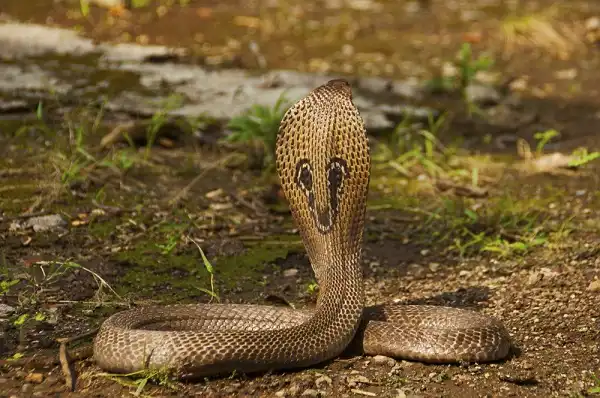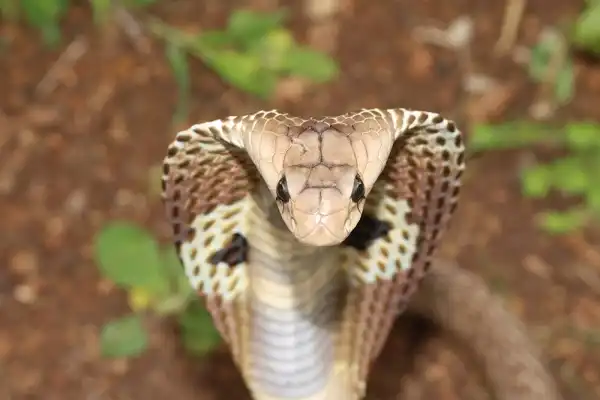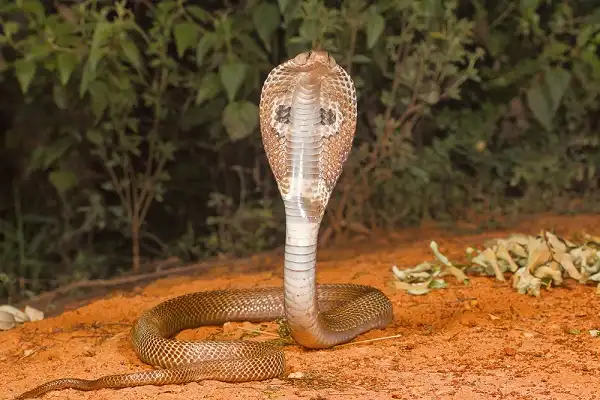The Indian cobra is a venomous snake found in the Indian subcontinent. It is also known as the spectacled cobra, Asian cobra, or binucleate cobra due to the characteristic “spectacle” markings on its head. The Indian cobra is considered to be one of the most dangerous snakes in India and is responsible for many human fatalities each year. Thankfully, anti-venom is available and bites from this snake can be treated if medical help is sought immediately. In this blog post, we’ll take a closer look at the Indian Cobra – their appearance, behavior, and habitat. Stay tuned for more!

Indian Cobra Description
The Indian cobra, also known as the spectacled cobra, Asian cobra, or binucleate cobra is a venomous snake found in the Indian subcontinent. This cobra species has an iconic hood that will flare when threatened or disturbed, while it also has a distinct pattern of yellow and black bands along its body which helps provide camouflage in its natural environment. The Indian cobra is usually light brown or olive green in color, but can also be seen in darker shades, depending on the area in which it resides. The head of the Indian cobra is wide and flat, and its eyes are small with round pupils that are capable of distinguishing different levels of light intensity even in poor visibility conditions. Its fangs contain a powerful neurotoxic venom, used by the snake for hunting and protection against potential predators. The venom contains several components including enzymes that cause paralysis, circulatory collapse, and respiratory failure as a result of bites from this species.
Indian Cobra Habitat
The Indian cobra is a species of cobra usually found in the Indian subcontinent and surrounding countries. They prefer warm and moist climates, so they can often be found near bodies of water such as rivers, streams, lakes, and ponds. They typically inhabit agricultural fields, forests, grasslands, wastelands, or other suitable habitats to find food and shelter. They may also be found in urban areas such as gardens and parks if there is an abundance of food sources available. Indian cobras tend to hide during the day and become more active at night when temperatures are cooler. During the warmer months, they take refuge in burrows beneath rocks or tree roots while during cooler months they may move into human dwellings or other buildings for warmth. If disturbed or threatened they will raise their hoods and hiss loudly while spreading out their skin around their necks to look more intimidating.
Indian Cobra Diet
The Indian cobra is an opportunistic feeder and will hunt small mammals, birds, lizards, frogs, and even other snakes. It primarily hunts at night or during the cooler months of the year when temperatures are lower. The diet of this reptile consists of a variety of prey items such as rodents, mice, small birds, reptiles, amphibians, and sometimes other snakes. During summer months they may also feed on insects. Their main prey items are usually animals that inhabit their immediate environments like agricultural fields and wastelands but they can also be found in urban areas if food sources are abundant there.

Indian Cobra Size
The Indian cobra is a large, venomous snake native to the Indian subcontinent and parts of South-East Asia. It can reach lengths of up to 6 ft (1.83 m), though they are typically smaller than this size with most adults reaching only 4-5 ft (1.2 – 1.5 m). This reptile has excellent physical abilities such as great speed and agility which help it catch its prey quickly. The Indian cobra is considered an apex predator within its range because there are few animals capable of preying upon them due to their potent venom; however, humans remain one of their greatest threats due to habitat destruction caused by urbanization or agricultural activities. Despite this, conservation efforts have been successful in some places where the species inhabit. It remains listed as ‘Least Concern’ on the IUCN Red List due to its widespread distribution across much of India and Southeast Asia.
Indian Cobra Lifespan
The Indian cobra is a long-lived species, with typical lifespans of up to 20 years in the wild and 25 years in captivity. They reach sexual maturity at around 2–3 years old and are known to breed throughout the year, depending on the availability of food sources. The female cobras lay between 10-20 eggs which incubate for up to 3 months before hatching. When threatened by potential predators or attackers the Indian cobra will spread out its hood around its neck area while hissing loudly as a form of a defense mechanism; this is usually enough to scare off most attackers regardless of whether they are human or animal. In terms of longevity, the Indian cobra can be considered relatively long-lived compared to other species within its family; however environmental factors such as habitat destruction or destruction from human activity can have drastic effects on their lifespan if not kept in check. Furthermore, since this species has become increasingly popular among snake collectors due to its beauty and size, over-collection has led to populations being depleted significantly in some areas of their range; conservation measures must be taken in order for them to continue living strong in the wild for many more generations.
Indian Cobra Behavior
The Indian cobra is a solitary species and prefers to hunt alone, however, it can sometimes be seen in pairs or small groups depending on the size of its habitat. During the day they are most active, although they may become more active at night if the temperature and humidity levels are right. It is diurnal in nature, meaning that it is active during the day when temperatures are higher; however, during cooler weather, it will move underground or hide beneath rocks or logs to avoid heat loss. In terms of behavior towards humans, this species can be quite docile unless provoked; however, if threatened they will hiss loudly before rearing up into an ‘S’ shape with their hood spread outwards as a form of defense mechanism. Bites from this species can be fatal due to the powerful neurotoxic venom injected by their fangs; as a result, when dealing with wild specimens extreme caution should be taken whenever possible.

Indian Cobra Speed
The Indian cobra is an incredibly fast and agile snake, capable of reaching speeds up to 7 mph in short bursts. This makes it difficult for predators or attackers to catch up with the snake, allowing it to quickly escape any potential danger. Not only this, but its powerful muscles enable it to climb trees and other vertical surfaces quickly and efficiently which gives it additional advantages over would-be pursuers. When hunting, the cobra will usually strike its target at lightning speed which often leaves its prey no time to react before being injected with venom; this deadly combination of speed and power allows them to take down large animals. When threatened by potential predators or attackers the Indian cobra will often flee rather than confront its attacker; due to its impressive speed, it can easily outmaneuver any would-be pursuer while also making use of its environments such as rocks and trees in order to seek cover. Additionally, its agility enables it to make sharp turns at full speed without losing balance which helps create confusion among its adversaries or allows it time to escape safely.
Indian Cobra Hunting
The Indian cobra is a highly efficient hunter, utilizing its speed and agility to quickly catch its prey. It will often strike out with lightning speed toward a potential target, injecting it with neurotoxic venom before it can react. This deadly combination of speed and power allows them to take down large animals such as birds, frogs, lizards, and even small mammals like mice or rabbits with ease. Furthermore, their keen eyesight gives them an advantage when searching for prey as they can accurately locate their target from a distance before moving in for the kill. Indian cobras also have impressive patience when hunting; they are capable of waiting for long periods of time until the perfect opportunity arises before striking out.
This strategy helps ensure that they expend minimal energy while still managing to secure enough food to sustain themselves. Additionally, this species will sometimes lie in wait near burrows or crevices where rodents and other small mammals might enter; by doing so they can quickly snatch up any unsuspecting prey that comes close. When confronted with larger prey such as deer or antelope, the Indian cobra will usually attempt to coil itself around the legs of the animal and constrict it until either unconsciousness or death occurs; this requires great strength which these snakes possess in abundance due to their powerful muscle structure. Furthermore, they also use their heads to hit their targets in order to stun them momentarily which makes it easier for them to subdue their prey with minimal effort expended.

Conclusion
The Indian cobra is a formidable species due to its impressive speed, agility, and neurotoxic venom which make it one of the apex predators within its range. Conservation efforts are still needed however in order for these snakes to remain strong for many more generations into the future; successful efforts have been made in some areas where this species inhabits and it remains listed as ‘Least Concern’ on the IUCN Red List due largely to its widespread distribution across much of India and Southeast Asia. Its hunting techniques also help ensure that it can successfully feed itself while avoiding confrontation with potential adversaries or dangers whenever possible. All these traits combined allow them to live comfortably within their environment while also keeping themselves safe from potential harm.
Frequently Asked Question


